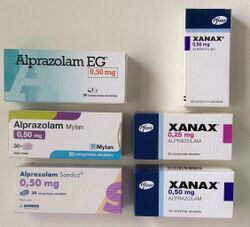Xanax
(benzodiazepine) | |
|---|---|
 | |
| Start | 1971 |
| A Pfizer drug peddled as a short term management of panic disorder but thanks to overprescription creates addiction. | |
Benzodiazepine is a type of drug sold under brand names like Valium (Roche) and Xanax (brand owned by Pfizer). Benzodiazepines depress the body’s central nervous system, producing a drowsy but calming effect. More than a million people in the UK are estimated to be addicted to benzodiazepines[1].
Popularity
Once seen largely as the province of psychiatrists, drugs like Xanax and Valium are now being prescribed by a growing number of primary care doctors for a growing number of conditions, many of them off-label. The number of doctor visits that ended with a prescription for benzodiazepines nearly doubled between 2003 and 2015[2]. In 2016, it was the 19th most prescribed medication in the United States, with more than 27 million prescriptions.
When people mix them with opioid painkillers, another widely abused drug, they’re at a higher risk of ending up to end up in the emergency room for an overdose and at a higher risk of overdose death. Alcohol is one of the most common interactions; alcohol and alprazolam taken in combination have a synergistic effect on one another, which can cause severe sedation, behavioral changes, and intoxication. The more alcohol and alprazolam taken, the worse the interaction.[3]
Benzodiazepine withdrawal syndrome
Anna Lembke, MD, chief of the Addiction Medicine Clinic at Stanford University, has called benzodiazepines “our other prescription drug problem.” She says doctors may not fully grasp how addictive benzodiazepines can be, just like they didn’t grasp the addictive power of opioids.[2] Quitting cold turkey can produce severe, even life-threatening withdrawal symptoms, and some users struggle to kick them completely after weeks or months of tapering off their doses.
Benzodiazepine withdrawal syndrome is the cluster of signs and symptoms that emerge when a person who has been taking benzodiazepines, either medically or recreationally, and has developed a physical dependence, undergoes dosage reduction or discontinuation. Development of physical dependence and the resulting withdrawal symptoms, some of which may last for years, may result from taking the medication as prescribed. Benzodiazepine withdrawal is characterized by sleep disturbance, irritability, increased tension and anxiety, panic attacks, hand tremor, shaking, sweating, difficulty with concentration, confusion and cognitive difficulty, memory problems, dry retching and nausea, weight loss, palpitations, headache, muscular pain and stiffness, a host of perceptual changes, hallucinations, seizures, psychosis. Further, these symptoms are notable for the manner in which they wax and wane and vary in severity from day to day or week by week instead of steadily decreasing in a straightforward monotonic manner.[4] This phenomenon is often referred to as "waves" and "windows".